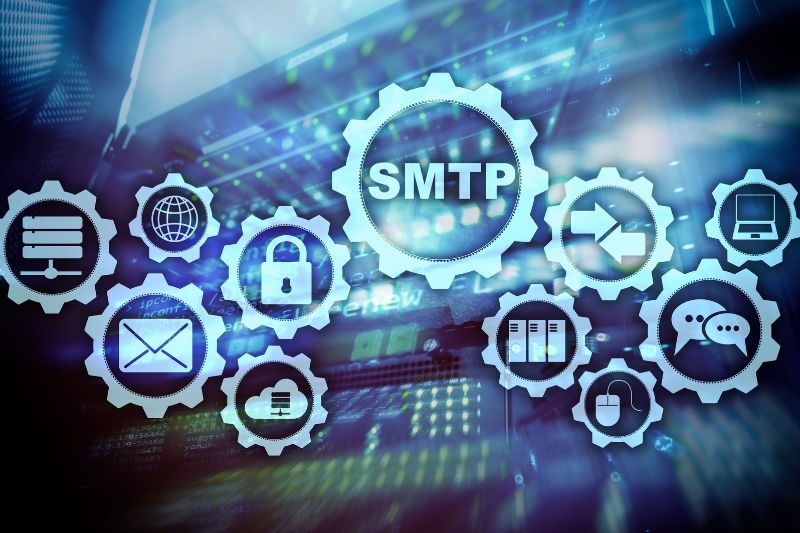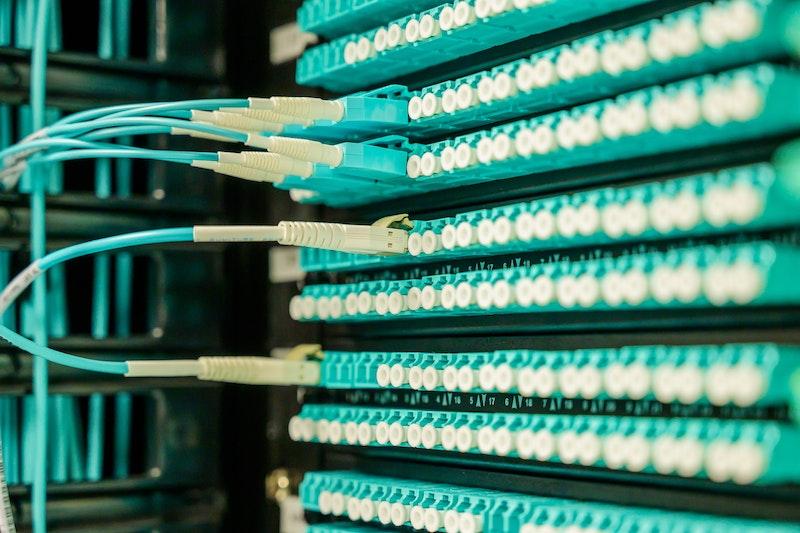Email is a powerful marketing tool that still plays a significant role in business and commerce. However, what many may need to be made aware of is the technology behind email communication called the SMTP server.
This server is essential, especially if you send your recipients many emails. Without an SMTP server, you won’t be able to send your email to its destination.
So, if you’re curious about what SMTP is or how it works to improve your deliverability, you’ve come to the right place. We’ve compiled all the information you need to know about it. You’ll also find here a list of the most essential SMTP commands with a brief explanation.
Let’s begin this in-depth guide by explaining what SMTP is:
What is a Simple Mail Transfer Protocol (SMTP) Server for Beginners?
An SMTP server is a computer or application that provides a service to other apps within a network, referred to as clients.
It explicitly handles the relaying, sending, and receiving of emails. In short, it acts like a “middleman” between the sender (you) and the recipients of your emails.
The SMTP server works by following the SMTP protocol. On the other hand, a Simple Mail Transfer Protocol is the same as an Internet Protocol (IP address). It is an email protocol used for the leading communication network and a part of the application layer of the TCP/IP protocol.
Email protocols are rules for digital communication. They allow different email accounts and clients to exchange data easily.
An SMTP protocol is among the most popular, alongside IMAP and POP. Email clients, such as Apple Mail, Outlook, Yahoo Mail, and Gmail, depend on SMTP to send messages from a sender to a recipient.
How Does an SMTP Mail Server Work?
Source: Canva/Funtap
Upon clicking the “Send” button on your email messages, your MUA (Mail User Agent) or email clients (i.e., Yahoo or Gmail) opens the SMTP connection to the server.
They often make this connection via SMTP port 25. Other ports, like the 465, 587, and 2525, may sometimes be used in different cases.
When they introduce your mail client to the SMTP server with a command, it will be followed by an SMTP server reply called the SMTP server handshake.
Then, the Mail Transfer Agent (MTA) will see the email client you used to send the message. If the mail client is the same as the recipient, MTA will immediately “push” the message to the receiver’s inbound SMTP server.
On the other hand, if the recipient used a different mail client, the MTA will first determine the client through the Domain Name System (DNS). Next, they will send the message to the correct server. It can also be sent to the backup or queued if the SMTP server is unavailable.
When the recipient’s email client gets the message, the SMTP server will send it to the inbox, where the recipient can open it.
What is an SMTP Port?
An SMTP, like the majority of networking protocols, is created to go to a specific port or a virtual location in a computer.
An SMTP port is a communication endpoint that handles the transmission of email data through the Simple Mail Transfer Protocol as it moves from one server to another in a network.
For instance, imagine a mail slot in a large building. Each mail slot is dedicated to a different resident in a building.
Your mail won’t guarantee delivery if you address it to the entire building because the wrong recipient may discard it. Therefore, you must address the mail to a particular mail slot owned by your intended recipient.
Apply the scenario in a network. A computer can make errors on the network data if it doesn’t specify a port. It can receive and pass the data to the correct process or application if directed to a specific port. The ports designated for SMTP are 25, 465, 587, and 2525.
SMTP Server Advantages
Using an SMTP server brings many benefits, like:
- Safe bulk emails and campaigns
- Extended area coverage at a lower cost
- Fast and reliable email delivery
- A dedicated server, if needed
- Outbound and inbound email delivery support
- Reports on your campaign’s performance
- Easy campaign data collection
Understanding the email marketing advantages and disadvantages can help you effectively align your SMTP server strategy with your marketing goals
What is My SMTP Server Address?
Source: Pexels
Your SMTP email server address is in your mail client’s settings or account section. It is generally in a smtp.serveraddress.com format.
For instance, Gmail’s SMTP address is smtp.gmail.com, while AOL uses smtp.aol.com. Here are other common SMTP server providers and their settings:
- AT&T: smtp.mail.att.net
- iCloud: smtp.mail.me.com
- Outlook: smtp-mail.outlook.com
- Yahoo!: Smtp.mail.yahoo.com
- Comcast: smtp.comcast.net
Every domain name, including the free SMTP hosting provider Gmail, has a unique IP address.
The SMTP server also checks if the sender’s email address is active before handing over the message to the recipient’s SMTP server. This process prevents spam emails from landing in their inbox.
How to Check If Your SMTP Server Is Working?
Sometimes, your emails won’t go through even if you use the correct email address and SMTP server. To fix this, test to know if your SMTP server is working or not.
Here’s an easy method to do that:
Step 1. Open the command prompt and type telnet with your SMTP address. Add the port address you use—for example, telnet smtp.gmail.com 25.
Step 2. You’ll receive a status code 220 if the SMTP is working.
Step 3. If you receive no response, a firewall or antivirus prevents your SMTP server from relaying your email.
Do you want to improve your overall deliverability? With protocols like SPF, DKIM, and DMARC records, you’ll improve your brand reputation with the inbox service providers and recipients.
How Do I Know If My Emails Are Using SMTP?
If your emails use SMTP, you can guarantee that such an application helps prevent spam. It also verifies the sender’s account before email delivery to protect your IP reputation.
To check if your emails are using SMTP and are sent securely, view the headers of your emails. This applies to most modern email clients, such as Outlook and Gmail.
While for Outlook users, open the email, go to the File tab and then Properties. You’ll see the email header data, which details transmission information, including whether encryption is applied.
For Gmail users, simply open the email and click the small arrow underneath the sender’s address next to your name. It may appear like this:
“security: Standard encryption (TLS)”
The security tab provides all information about the encryption type used to secure the email and the domain that signed the certificate.
How Is SMTP Different From Other Email Protocols?
Remember when we mentioned that SMTP is just one of the many email protocols? (See: What is a Simple Mail Transfer Protocol (SMTP) Server?) And that IMAP and POP are the two other popular email protocols in use?
SMTP differs from other email protocols because it is the only protocol for “pushing” or sending emails from an unknown mail server to another. Meanwhile, the other email protocols are for “pulling” or receiving email from the recipient from their own mail server.
Other email protocols, including IMAP and POP, limit mail transfer to verified users only. It also can’t be used for emailing outside your network.
To reiterate, SMTP is used to send email, while other email protocols are used to receive email.
What Is the Difference Between SMTPS and SMTP?
By default, SMTP is more secure and private than no authentication or encryption. However, you can use it to send data without any protection. This leaves email with the SMTP setup susceptible to eavesdropping or attacks from bad actors while the data is in transit.
Others call such an attack an SMTP injection. Attackers inject malicious SMTP commands into the data to steal sensitive information silently, send spam, or conduct phishing.
In contrast, SMTPS uses additional SSL or TLS cryptographic protocols for added security. Thus, there’s an extra “S” for SECURE.
You can use other email standards to protect your email and domain. These include the Sender Policy Framework (SPF), Domain Keys Identified Mail (DKIM), and Domain-based Message Authentication Reporting and Conformance (DMARC). Read this quick SPF, DKIM, and DMARC guide to learn more about these email standards.
Hosting Your SMTP Server vs. Using a Third-Party Email Service
Source: Pexels
You can host your own SMTP server or use a third-party email service to manage your email marketing campaign.
Both have their advantages and disadvantages. Let’s find out what these are:
Running Your Own SMTP Server
Hosting your own SMTP server gives you complete control over the security and privacy of your mail. However, it can be both a good and bad thing. It means you have fewer limits in email sending, but getting the hang of it may also take time and effort.
More specifically, you save money because you’re not paying for a third-party email service, which means no storage fees. Yet, that money may just go to updating your security software.
No email volume limits exist; you can host multiple domains using a non-shared IP address. All of these are a good thing. However, it could also mean having higher bounce rates, increasing your chance of getting blacklisted, and that you may have to store backup data using a different location.
Related: Blacklisted Email – Mistakes Happen: How to Get Off of Email Blacklists
Using a Third-Party Email Service
If you run a website, you’ll need a transactional email functionality to communicate with your customers more effectively. You can outsource and use a third-party email service if you can’t access the SMTP service via your hosting provider.
Some of the best SMTP server providers include Sendinblue, Mailgun, Amazon SES, and SendGrid. All these are user-friendly platforms with APIs for sending, receiving, and tracking emails.
The advantage of using a third-party email service is it’s more secure and requires less technical knowledge than running your own SMTP server. Plus, it is cost-effective and offers more reliable deliverability.
However, it also comes with downsides. For instance, you’ll rely on a third-party company for support whenever an issue arises. So, you must follow their terms and conditions. It also means having to face limitations.
The pricing model varies by vendor. Some offer a monthly price for a certain number of email users you send. Meanwhile, others provide pay-as-you-go models or paid plans monthly.
Basic SMTP Commands
Each SMTP command is used in a communication sequence between two servers via SMTP protocol to deliver emails.
In addition, each session comprises a handshake, email transfer, and termination. The basic yet important SMTP commands include the following:
HELO
This is the first and most important SMTP command because it identifies the sender server and domain name to start the conversation.
EHLO
This command is an alternative for initiating an SMTP conversation. It’s where the email client greets the server and introduces itself. You can also use it for servers that support SMTP service extensions or ESMTP.
MAIL FROM
This command specifies the sender of the mail. It determines if a new email transfer is about to happen in the SMTP server. It responds to a status code 250 if the server accepts the transaction.
RCPT TO
This command specifies the recipient of the mail. If it finds multiple recipients, it simply repeats address by address.
DATA
The DATA command defines that the information is data. With this command, the email content will start to transfer and is generally followed by a reply code 354 assigned by the server. It provides permission to begin the transmission.
SIZE
This command tells the remote server of the email attachment’s estimated size (in bytes). You can also use it to report the maximum size of the email the server allows.
VRFY
This SMTP command asks the server to verify whether a user name or email address exists.
TURN
This command reverses the sender and client roles without using a new connection.
RSET
In case of an error, this command terminates the current email transaction. It resets the connection without closing the SMTP connection. They send it to the server, where they delete email-related data.
AUTH
This command authenticates the client to the server by sending its username and password. It is another layer of security to ensure proper transmission.
HELP
Using the HELP command, the client can ask the server for commands (supported by the server) it can execute. If the server can accommodate the request, it will respond by providing the data.
EXPN
This SMTP command verifies the existence of one or more mailboxes on the system.
QUIT
This command ends the SMTP connection once the survey returns the SMTP response 221. Some SMTP servers support extended SMTP commands.
SMTP vs. IMAP and POP
Differences Between SMTP and IMAP
- SMTP is used to send data, while IMAP is for retrieving messages.
- SMTP transfers information between servers, while IMAP works for communication between the client and server.
- SMTP enables organizing emails on the client storage, while IMAP is on client storage.
Differences Between SMTP and POP
- SMTP is a push protocol, and POP is a pop protocol.
- SMTP sends and delivers data from a client to a server through port 25. It is an outgoing server. Meanwhile, POP is for retrieving and organizing emails from the receiver’s mail server to the receiver’s computer. It is an incoming server. The latest POP version is named POP3, which uses port 110.
FAQs About SMTP Servers
Is an SMTP server the same as a normal server?
Yes and no. An SMTP server is like most servers in that it processes the data it sends to another server. However, it has a specific purpose of processing data related to relaying and sending emails.
However, an SMTP isn’t the same as a standard server because it doesn’t perform on a personal device or machine. Still, an application is constantly running in expectation of sending new mail. Other protocols, like IMAP and POP, were developed for that.
What are the five mandatory commands used in SMTP?
There are no mandatory commands, per se, but there are essential SMTP commands. These include the HELO/ EHLO, MAIL FROM, RCPT TO, DATA, SIZE, RESET, VRFY, and QUIT Commands.
Should the SMTP server be port 25 or 587?
Initially, SMTP uses port 25. But today, it is recommended to use port 587 as it is for encrypted email transmissions using SMTPS (Simple Mail Transfer Protocol Secure). Sometimes, it uses port 465, but it’s an outdated implementation.
Is SMTP POP or IMAP?
No, they’re different. The primary function of SMTP is to send emails, whereas POP and IMAP are for receiving emails.
Final Words
Source: Canva/Getty Images
We’ve covered the most essential questions about Simple Mail Transfer Protocol (SMTP) Server.
We hope this guide will help you work with the SMTP service to become more convenient and accessible. Learning it may take time, but it will be beneficial, especially if you manage email lists or promotional messages.
Our team wishes you the best in crafting the best email marketing strategy.
Need a helping hand on your path to email-sending success? InboxAlly can help you. Find out why it is trusted and used daily by leading email marketing professionals worldwide.



